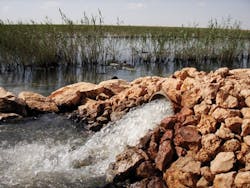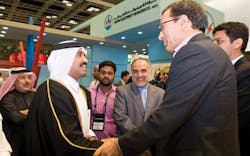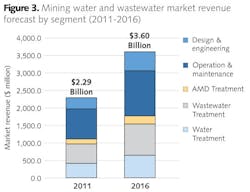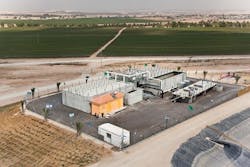Panama may be renowned for its Canal expansion news, but plans for improved wastewater treatment are also grabbing headlines. A US $516 project aims to increase the current figure of only 60% of inhabitants connected to the sewage system in the city. Mauro Nogarin provides an update to the developments.
The government of Panama has been planning a project to clean the Bay of Panama for many years. The main objective is to clean residual waters which are discharged into the bay and surrounding streams and eventually recover the region's natural state.
According to information gathered by the Ministry of Health and National Institute of Aqueducts (IDAAN in Spanish), only 60% of inhabitants are served by the current sewage system in the city. Most of these residual waters are gathered through septic tanks, but due to maintenance of the system it is not adequate and the waters are dumped into the bay with practically no treatment at all.
Credit: MSCP
There also are many industries which dump illegally residual waters highly contaminated with grease, metals, chemicals and animal wastes. Only a very small percentage of residual waters make it to the waste treatment plants; most of which are undersized and do not receive the necessary maintenance.
Part of the interceptor tunnel
Credit: MSCP
Due to this unsustainable situation and to manage the demographic growth of the city and economic growth of the country, the Caribbean nation in 2006 took the first steps, under the supervision of IDAAN, to construct a new water treatment system for the Bay of Panama and the installation of new sewage system, called the interceptor (tunnel) system and Residual Water Treatment Plant, set for completed in 2013.
Until the end of 2011 bids will be accepted on the second stage of Juan Diaz (Llano Bonito) recollection plant, construction of the recollection plant for Curundu and construction of the second phase for the sewage network for San Miguelito. The cost of the entire project will be US$516 million, of which US$64 million will be financed by the national government, while the balance will be financed through international loans (as detailed in table 1).
Based on the master consolidation plan created in 2001, the Treatment Project for the City and Bay of Panama is divided into four key areas, including sewage networks, collection of wastewater, interceptor system (tunnel) and wastewater treatment plant (PTAR). This master plan study for water treatment for the City and Bay of Panama is part of the PAN/97/003 "Technical Cooperation and Support to the Reform Program to the Basic Infrastructure" financed with resources from a loan from the Inter American Development Bank (IDB) and the Republic of Panama.
Credit: MSCP
Plans show that once residual waters are collected, they are transported by a pipe network that runs inside the rivers to locations near the coast, where they join the Interceptor Network (tunnel) that channels them to a pipeline system. This will be operated by gravity flow and pump stations, which directs the entire flow of wastewater to Juan Diaz, where biological treatment takes place at the wastewater treatment plant, in order for the outflow to meet Panamanian environmental standards.
The project will come online at different stages. At the end of 2012 the treatment plant, which is being built by Odebrecht Brazil, will be operational and afterwards the Interceptor Tunnel will enter operations in 2013.
General schematic of the new treatment plant for the city of Bahia de Panama
According to the report by the Ministry of Health of Panama, in April of 2011, the sewage system was 100% complete, as were the downriver collection facilities, the Juan Diaz collection plant, and the Tocumen collection network. The Matias Hernandez collection facility was 99% completed. The Interceptor Tunnel is 66% completed, and the collection network that operates in the tunnel is 47% completed. Furthermore, the water treatment facility plant is nearing 45% completion and the Lajas collection network is 34% completed.
Sewage treatment plant
After the Ministry of Health selected five potential locations, environmental engineering group Hazen & Sawyer compared the sites and finally selected location 2A as having the highest technical score. Together, the required infrastructure covered an area of 85 hectares, of which 32 are for the installation of the sewage treatment plant. In the conceptual design prepared by Hazen & Sawyer, the technology for secondary treatment of residual sludge has the goal of leaving the end product with a maximum of 10 mg/l of total Nitrogen (TN), according to Panamanian environmental standards.
DRILLING DEEP: TECHNICAL DIRECTOR INTERVIEWGeological studies conducted in the area where the sewage treatment plant was to be built, revealed that the ground down to a depth of 12 metres was unsuitable for building. Engineer Colombo Biserna from Italian engineering group, Trevi, was the technical director for the construction of the tunnel access and three pumping stations. It was decided that the project would use dry pylons 1.2 meters in diameter placed one meter apart. In total 336 pylons were placed, drilling a total of 9,448.5 meters. The work took place between March and October of 2010. Here Biserna discusses the work:
Q: Can you describe the type of ground that you found suitable for the project?
A: The first thirteen meters were mud, clay and sand, but after the 17th meter and to the 30th we detected sandstone of suitable consistency.
Q.: What type of machinery did you use?
A.: Considering the three month window we had to work in, we used a Soilmec R930, SR 70, R825 and R822 drilling rig. In each one of them we used 1.2 meter accessories for the fill buckets or to drill the rock or through concrete.
Q.: What were the greatest technical difficulties you encountered?
A.: Maintaining perfect verticality of the pylons and pouring the concrete with 35 Mpa RCS instead of using 15 Mpa as had been planned in the original project.
THE PROCESS
The main processes of Biological Nutrient Removal (BNR) treatment begins with the sieving process, followed by a de-sanding forced vortex camera to remove sand, gravel, dust and other solid materials. In the biological treatment phase, the liquid cultivates a population of bacteria and other micro-organism found in the liquid environment. The organic matter is dissolved and converted in a form that can be processed by the sediment separator. The aeration system is made up of sprayers with fine ceramic heads placed at the bottom of the aeration tanks.
Secondary clarifiers provide a calm area to allow sedimentation of suspended particles after being processed by the aeration tanks. In the middle of the clarifier tanks a pumping station is located with the following characteristics: a centralised wet trench for flow control of sludge, return pump, a pump for actives and a pump for foam.
The wet trench holds the sludge before sending it on to the aeration tanks, while the return pumps for activated mud (RAS in Spanish) transports the solids removed from the secondary clarification located in the aeration tanks. This is in order to maintain the active biological mass, which is responsible for the biological degradation which takes place in the tanks.
FINAL Disinfection
Excess activated sludge is continually discarded from the system to maintain a stable level of suspended solids in liquid mix in the aeration tanks. To comply with Panamanian environmental regulations for residual water discharge, the Juan Diaz treatment plant will have facilities for chlorination of the effluent before it is discharged into the Bay of Panama, providing a final disinfection step.
Construction of sedimentation tanks
The final discharge takes place through 1.6 km of mangrove swamps and 2.5 km of coastal area through a 100 meter sprayer located below low tide level. In the coastal areas the pipe is 108 inches in diameter and is supported on the surface by its own weight in the mud, while the mangrove swamp area runs parallel to the access road to the port of Juan Diaz.
The Hazen & Sawyer company recommended the implementation of an anaerobic digestion facility through the use of lye as a stabilising agent, after doing several feasibility studies, for the management of sludge at the Juan Diaz treatment plant, due to its low cost at a lower efficiency level.
Odour control is included among the auxiliary processes in the new treatment system, which is accomplished through pre-treatment. This includes the construction of ducts that remove the air that builds up inside by maintaining a slightly negative air pressure in the pre-treatment facility, avoiding the release of foul smelling gases and permitting them to be adequately filtered before being released into the atmosphere.
Additionally, activated charcoal absorption units were installed to ventilate the gases generated by the foam pumping station.
More Water & WasteWater International Current Issue Articles
More Water & WasteWater International Archives Issue Articles








